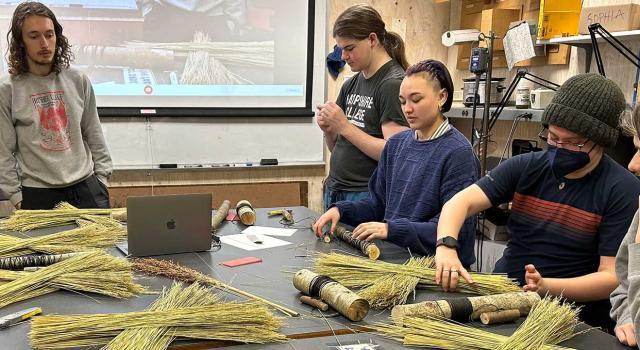Testing the Chemistry of Mummies and Toxic-Metal Pollution
For her Division III thesis, Madison McDonald is examining strands of mummy hair to determine whether ancient Andeans in South America thousands of years ago were exposed to lithium in the environment. She and other Hampshire students using one of the most advanced instruments for analyzing chemical properties of solid materials, courtesy of a National Science Foundation grant of nearly $200,000.
In November the College installed a new mass spectrometer — specifically, an inductively coupled plasma-mass spectrometer (ICP-MS) coupled to a laser ablation system — which generates minute particles from a solid object for elemental analysis. This ICP-mass spectrometer is the latest version of an instrument that Hampshire has made available to students for a couple of decades.
The hair that McDonald is analyzing comes from the oldest mummies in the world, from a population of Atacama called the Chinchorro people who were mummifying their dead (in what is now Chile) thousands of years before the Egyptians did. McDonald says analytical chemistry is enabling her and other scientists to better understand how these people lived by revealing what they were exposed to in their environment.
Two other students are using the mass spectrometer for their Division III projects. Emma Zyskowski is studying heavy-metal pollutants in trees using samples from a highly polluted mining community in Hunan Province, China. Avery Hernandez is studying ways to remove pollutants from contaminated soil and water, using samples from that same community, the city of Lengshuijiang, site of the Xikuangshan (XKS) mine.
All three students are working closely with Professor of Chemistry Dula Amarasiriwardena, an expert in heavy-metal pollution of soil, plants, and water, who oversaw the acquisition of this latest instrument with Professor of Biological Anthropology Alan Goodman.
Hampshire's veteran chemistry professor says the new mass spectrometer features “increased sensitivity that allows for even more delicate research. We’ll be able to get very fast data collection, including detection of metal nanoparticles.” The instrument will facilitate better environmental monitoring of water and food systems, he says, to improve public health and support food security.
Hampshire's unique academic program empowers many science students to progress to author papers and articles on original research, often in collaboration with faculty, and to submit them for conference presentations and journal publications, a rare opportunity for undergrads. For a list of Hampshire’s published undergraduate authors, visit hamp.it/SciAuthors.
[Published research and presentations coauthored by Dula Amarasiriwardena with his students from Hampshire and the Five Colleges:
Publications
Presentations]
Emma Zyskowski hopes her work with the spectrometer will help yield ways to assess and treat pollution. The instrument can be used for a range of analyses, she says, from liquid to solids. She has used the spectrometer extensively, testing everything from tree cores for her Division III thesis to water samples for irrigation.
Avery Hernandez and Amarasiriwardena went to China last summer to retrieve samples of soil contaminated with the chemical antimony, a carcinogenic metalloid element. Like Zyskowski, Hernandez says he hopes his work will lead to cost-effective ways of removing the pollutant from affected areas. Communities in developing nations are often affected by the pollution, he says, which threatens their agriculture, water, and wildlife.
After graduation, Hernandez hopes to get a job in analytical chemistry research before eventually pursuing an advanced degree, and he believes his experience with this instrument will qualify him for laboratory work.
For Reference
Division III Titles
Avery Hernandez “Antimony adsorption onto kaolin-coated nanoscale zero valent iron in porous and aqueous media”: development and characterization of clay-coated iron nanoparticles to adsorb antimony in contaminated sites
Madison McDonald “Were coastal Atacama mummies exposed to environmental lithium?”: Looking at exposure to lithium using single strands of hair
Emma Zyskowski “Investigation of pollution history in XKS mining area in China using dendrochronology and LA-ICP-MS”: unraveling past pollution events in XKS mining area in China using elemental dendrochronology



